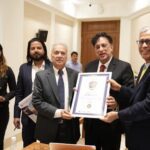By: Dr P N Renjen, Senior Consultant, Neurologist, Indraprastha Apollo hospital
According to the World Health Organization and other leading stroke experts, stroke claims 6.2 million lives each year.
World Stroke Day is observed on the 29th of October each year in order to focus world attention on stroke and its impact on human life. This year, the theme for world stroke day is “What’s your reason for Preventing Stroke”. The stroke day proclamation highlights stroke as a preventable and treatable catastrophe. More than fifth of all strokes occur in developing countries. The lifetime risk of stroke after 50 years of age is one in five for women and one in six for men.
“It is like a heart attack for the brain, where part of the brain does not get blood supply… when your brain is not getting oxygen, not only does it not function properly, but you can lose capabilities for the rest of your life. That’s why we talk about reacting so quickly to these things,” Dr. Renjen explains. He stresses when it comes to strokes, “Time is brain,” and the quicker you seek medical attention the better.
The number of deaths and persons disabled due to stroke is rapid in India. Increasing life expectancy at birth, rapid urbanisation, changing lifestyles and rising stress levels are bound to increase stroke cases.
Those suffering from high blood pressure, diabetes, high blood cholesterol and intake of oral contraceptives are especially at risk.
The incidence of stroke is the same for men and women till the age of 50 years and after that the women are at higher chances of developing stroke.
- Vegetarians are more prone to stroke because of deficiency of Vitamin B12 which causes increase in the level of homocysteine which accelerates process of atherosclerosis.
In a country like ours in addition to comprehensive Stroke programs with expertise, it is important to stress the importance of public awareness program to stress the fact that stroke is treatable and preventable in addition to access to remote areas of India to stress the importance of prevention and treatment of Stroke. Electronic and print media can be used more aggressively to promote the concept of healthy living and stroke prevention in this country.
Stroke symptoms can take many forms, including these:
- Numbness or weakness in the face, arm, or leg. The symptoms may include a drooping face, slurred speech, or paralysis of a limb. Often only one side is affected.
- Confusion. A stroke can make it difficult to speak or understand words (aphasia).
- Vision problems. Vision may dim or be lost entirely in one or both eyes. It may also become difficult to move the eyes.
- Trouble walking. Stroke can cause staggering, poor balance, and a sense of dizziness, clumsiness, or impaired coordination.
- Severe headache. A stroke may cause a sudden, violent headache
Women may report unique stroke symptoms: sudden hiccups, sudden nausea, sudden general weakness, sudden chest pain, sudden shortness of breath and palpitations
Effects of a stroke
It is possible for a person who has a stroke to suffer little or no brain damage or long-term disability, especially if the stroke is treated promptly. However, stroke can also cause severe brain damage and disability or even death. The type of disability caused by a stroke depends on the extent of brain damage and what part of the brain is damaged.
Stroke may cause paralysis or weakness of one side of the body, an inability to walk, permanent memory problems, mood changes, trouble speaking or understanding speech, problems with eating and swallowing, pain, depression, and other problems.
That’s why it is important to increase the awareness “Time is brain’ and treatment started early and the use of thrombolytic agents in first 4.5 hours after stroke decreases the mortality and morbidity of stroke
#Rehabilitation and medical treatment can help a person recover from the effects of stroke and prevent another stroke from occurring.
How to prevent a stroke
Important tips that can help you improve your chances preventing further a stroke.
- Keeping blood pressure in Check
- High blood pressure is a potent risk factor for stroke
- If the higher number (systolic) is more than 135, or if the lower one (diastolic) is more than 90, you should go to a doctor to be evaluated for high blood pressure.
- Lifestyle changes and perhaps medication may be in order to bring your blood pressure back into the normal range.
- Diabetes
- Like high blood pressure, diabetes does not cause any obvious symptoms until it is in its advanced stages.
- If you have not done so recently, go to a doctor and get your blood sugar checked. This is especially important if you are overweight or if other people in your family have diabetes.
- Quit Smoking
- If you have a family history of stroke or any other stroke risk factors, such as high blood pressure or elevated cholesterol, quitting smoking can significantly reduce your stroke risk.
- Lose Weight and Exercise
- If you are overweight, losing a few pounds is an excellent way to minimize your stroke risk. Eating less and eating healthy is the most effective way to accomplish this, especially when combined with physical activity. Even a brisk walks for half an hour or so per day can help you lose weight and decrease your chances of ever suffering a stroke.
- Know and Understand Your Cholesterol Levels
- Low density lipoprotein (LDL) is the bad kind of cholesterol and a reliable marker of heart disease and stroke.
- Eat a Healthy Diet
- Eating a healthy diet is probably the most effective way of keeping a low stroke risk, because it can protect you from developing high blood pressure, diabetes, high cholesterol, obesity, and more.
- Look after your heart
- An irregular heartbeat or other heart condition is linked to 9% of strokes. Talk to your doctor about possible treatment to reduce your risk.







